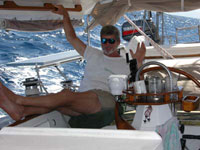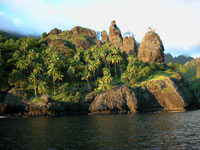|
HOME |
LOGBOOK |
| 2C Update #110
Half-prepared to motor the whole way, we found ourselves blessed with 12 knots of wind out of the ENE, perfect conditions for a rousing six-hour close reach. After all the days of restricted sailing on the passage, this terrific sail was a great reward for our hard won repairs!
And is the island beautiful! As we closed, the green pyramid unfolded to reveal steep cliffs and craggy ridges. Sailboats at anchor in the notch of Hanavave are dwarfed by towering pinnacles and ridges that seem to layer back into the mountainside like flats of theatrical scenery. Hanavave's Bay of the Vierges (Virgins) is another area that was originally named Baie des Verges (Penises). Our first encounter with the missionaries' one-letter name changes was in Mexico's Copper Canyon (see Update #93) In both places the original name much more aptly suggests the landscape. We found fourteen boats -- all European but for one Canadian and one New Zealander -- at anchor in the tight quarters available and were forced to put our hook down in 65 feet of water! This was just a tad unsettling when the 30-knot gusts blew during the night! The exhilaration of our sail and our picturesque arrival was unfortunately dampened over the next couple of days as symptoms of the flu crept aboard. I (Gwen) first went down with chest cold symptoms which escalated to all-over body ache and low-grade fever. How anyone can get sick on an open air boat eating the truckloads of fruit we have been eating is a mystery to me. No other cruisers have reported catching anything.
So the hike to waterfall and fresh water pool was out, as was the climb to the ridge above town or across to the island's other village. We did walk the length and breadth of town and a bit of a ways upriver into the forest, shopped the tikis and tapas of the local craftsman (Fatu Hiva is one of the last places tapa cloth -- cloth made from the beaten bark of banyan, breadfruit or mulberry trees -- is still made), and traded T-shirts for pamplemousse and bananas. Several children befriended us in hopes of "bonbons", but even when none materialized, Geordi gave me several beautiful flowers to put in my hair. Before the bug was really entrenched we did partake of a traditional Marquesan dinner ? complete with pig roasted in the earth. One of one of the European boats had organized the affair and attending were about twenty-five cruisers including several families with kids and encompassing at least three languages -- German, French and English. The dinner was served on a long table under a tent in the front yard of one of the local houses. The lady of the house -- Tia -- was a generous woman wearing a sport bra on top and a pareu wrapped around her hips. Huge bowls of poisson cru (raw fish in coconut milk), fei (a plantain-like banana) in coconut milk, chicken nuggets with wilted watercress, shredded green papaya salad with fresh watercress, rice and smoky sprouted coconut (the only dish that was not a hit) reached from one end of the table to the other. In the dark, the pig was dug out of the ground from beneath the layers of hot coals where it had been baked in pieces. As soon pork was on the platters and the pit was abandoned all the local dogs were in it head first! During the course of the meal, Tia would cluck over her guests, scoop more food onto your plate and wrap her arms around you to cut the tough meat with one of the few knives on the table. Later, someone put on some local music, and Tia gave us our first exposure to what Polynesian hips can do to the right tune. Latin meringue dancers haven't got anything on Tia. Nobody's got anything on Tia!
After our fourth night in Fatu Hiva it became clear that my bug wasn't going to clear fast enough for us to do any hikes. I was sleeping much of the day and Don was tired of the anxiety over the gusts and the depths, so we packed up and sailed back to Tahuata in another great day of sailing. Just to be different, we approached the lee side around the ragged southern point of that island which afforded us some more dramatic landscape as the winds raced through the gaps. We finally caught a fish just was we were about to bring the line in, but it flopped out of Don's hands and back into the sea! Good thing my German dinner-mate from Fatu Hiva pulled in with his two-meter wahoo which he kindly shared around the anchorage in time for dinner! For the record, we were very glad we made the trip. Would we have been as glad if the sails down and back had been more of a bash is hard to say. For cruisers reading this before their crossing, I would at least consider the quick stop at Fatu Hiva on the way in if conditions are settled. Stay aboard and sleep the first night, and then go in for the one or two days you can finagle from the gendarme. That way at least you don't miss the memorable landscape and you have a little time to seek out some crafts. Then if you fall in love with the place, you still have the option to sail back. I'd guess of the other non-US boats at anchor there with us about two-thirds of the boats had, like us, already made their official arrival in Hiva Oa. On the other hand, probably half of the Mexico fleet snuck a stop inbound. |
||||||||||||||||
|
home
| waypoints | logbook | reference shelf
|


















